Jaden Smith and his sister Willow are no strangers to courting attention with their looks. In fact the free-spirited, fine-featured teen siblings are probably some of the most potent fashion plates out there. A few days ago Jaden made a stir when he announced on Twitter that he was shopping for girls’ clothes at Topshop and was wearing a dress sans pants. Images followed and the internet erupted. The young Mr. Smith ignited a fashion discussion about gender and the appropriateness of men wearing women’s clothing that has been ongoing in pop culture and on the runway for years. Jaden’s recent gender-bending antics present the idea of a boy in a dress not as a gimmick or a fad but as an actual and valid shift in contemporary style.
When you swerve too hard — GQ Magazine (@GQMagazine)April 10, 2015
While women wearing pants has slowly become normalized over the last century (a French law forbidding women wearing pants was officially rebuked in 2013) the opposite phenomenon — men in skirts or dresses — is practically non-existent in the Western world. When it has been remotely acceptable for men to wear a dress it’s been as a farce or for drag; in a segregated safe space where the intention is not to appear as man but as an approximation of a woman, a fantasy character. And outside the drag club or the ball it was utterly taboo.
Stars of the music world have always been at the forefront of questioning gender norms. From Little Richard wearing makeup in the 50s to Bowie’s androgyny in the 70s, from The New York Dolls to Boy George, rock stars have been able to push boundaries and question gender roles with makeup and of course style. But for all of their shock tactics few have ever donned a dress, none have ever dared to go that far. It wasn’t until the early 90s when grunge messiah Kurt Cobain wore dainty dresses, perhaps as an anti-fashion statement or an expression of his own sexual ambiguity, that a musician would push the idea to its natural conclusion.
But maybe it’s actually the fashion world’s responsibility to reach those conclusions. In the 80s, iconic stylist Ray Petri pushed things along. Mixing elements from a broad spectrum of cultural backgrounds, he is known for his play on masculine and feminine tropes. Styling for magazines like i-D and The Face he would underscore male model’s muscular bodies with a kilt or, even more daring, a leather skirt. The effect was not a parody of a woman but the liberation of the man. Petri was a big influence on designer Jean-Paul Gaultier, who took the idea of gender play to the max, putting men not just in dresses but corsets and gowns. Gaultier’s provocative costumes did not have a huge impact on popular style but it did give the idea visibility.
Since then the world has changed, and Jaden’s newest sartorial interests reflect that. Today, gender and the barriers it has put up between men and women are going by the wayside. Women’s equality is greater than it’s ever been in the history of the world (though of course there’s still a long way to go), non-gendered bathrooms are becoming the rule rather than the exception, transgendered people are slowly but steadily gaining recognition, and RuPaul’s Drag Race is one of television’s most popular series. Amidst all this, the social shame and perceived immorality of a man in a dress is beginning to dissolve, and the dress’s significance as a default symbol of femininity is fading.
Jaden’s fashion epiphany wouldn’t have happened without recent innovations by designers like Shayne Oliver of Hood by Air and Givenchy’s Riccardo Tisci. In Oliver’s earlier collections he adapted the silhouette of urban basketball players, realizing that their shorts, with their slight A-line and drape, were basically skirts. Worn with an oversized jersey the effect is perhaps not all that different from styles worn in the medieval era when tabards and tunics were worn with leggings; the proportions are largely the same. Tisci has investigated the same ideas for Givenchy’s menswear. Both designers have opted to put men in actual skirts, styled and presented with a casual nonchalance. Kanye West, who had already experimented with wearing women’s designer clothes, wore a leather Givenchy skirt on stage in 2012 and proposed the idea to his hundreds of thousands of fans.
Last season saw three of New York’s youngest and most provocative menswear designers, Oliver included, showing knit dresses for men. They were easy, seductive and not totally unbelievable. And they were probably designed for young men like Jaden — 17 years old and of a generation that is more liberated from gender and sexual bias than any other before it. (Mostly more liberated: Oakland teen Sasha Fleischman’s skirt was set on fire on an after-school bus ride.) Still — though Jaden is privileged due to his wealth and celebrity, not to mention his supportive parents — he is likely indicative of many young men around the world who are open to more progressive ideas of dress, unbothered or unaware of centuries of tradition and conservatism. The truth of the matter is that Jaden, in his tunic dress from Topshop, looks quite good. And a good look with a broad audience is sometimes all fashion needs to help it move a little bit forward.
Credits
Text Jeremy Lewis
Photography Columbine Goldsmith
Styling Djuna Bel
